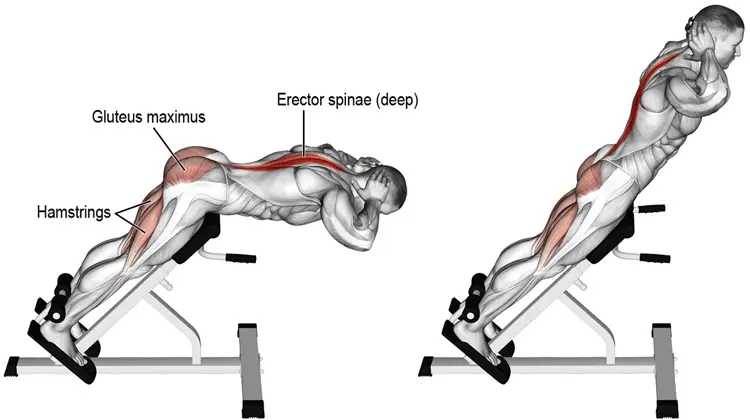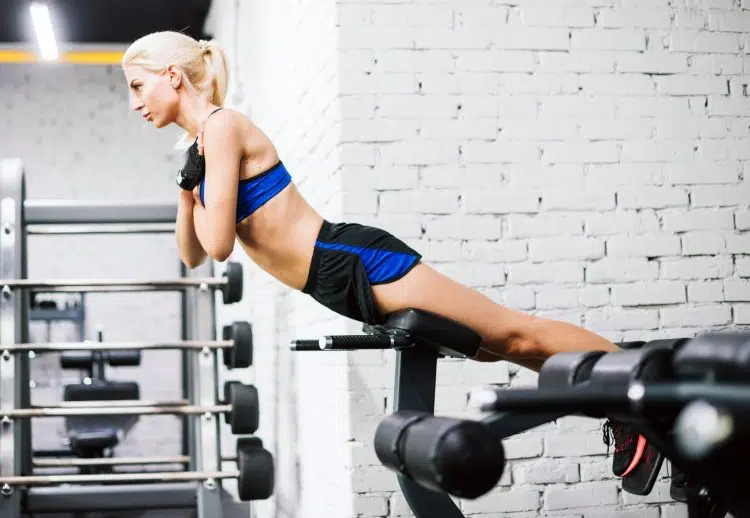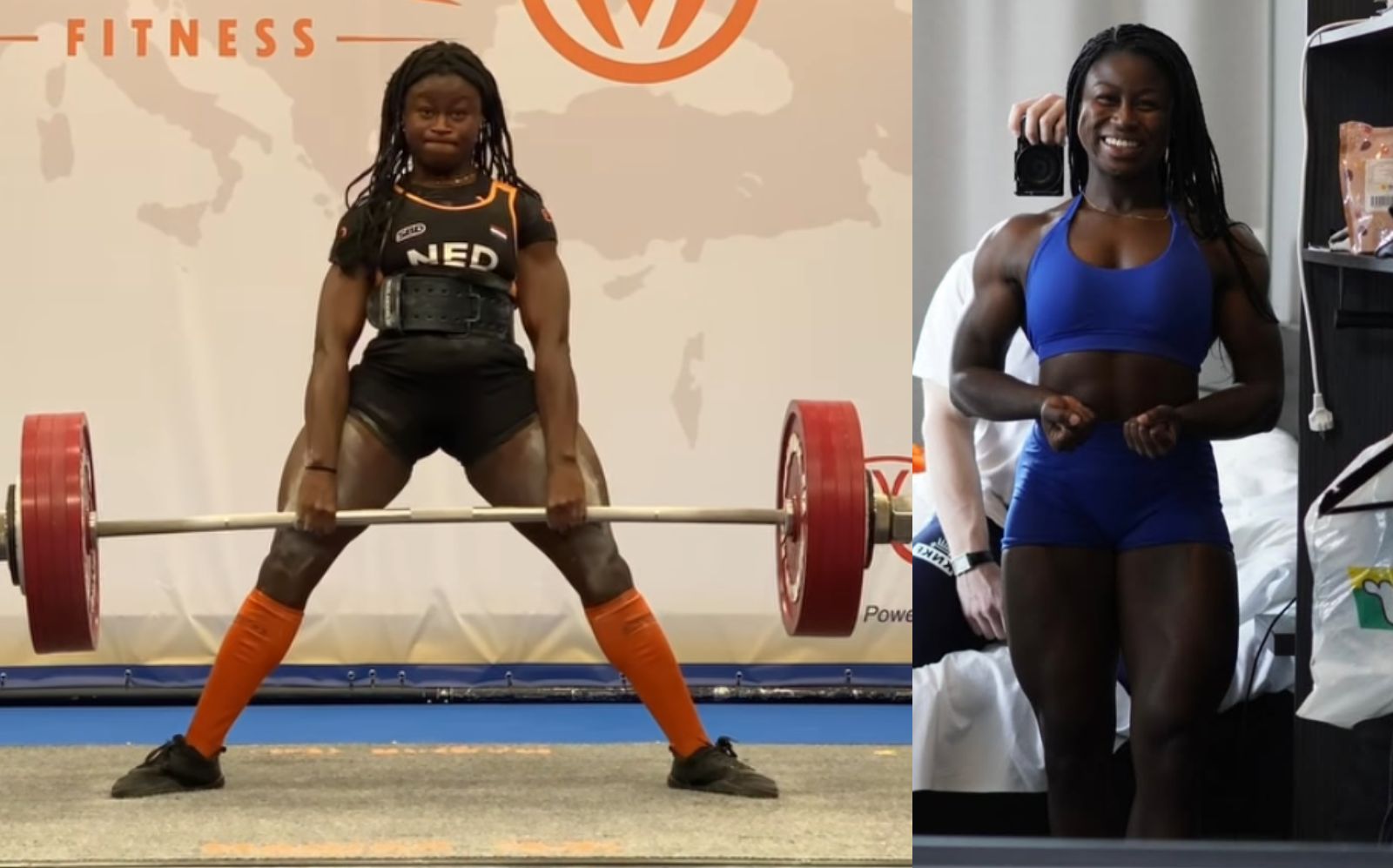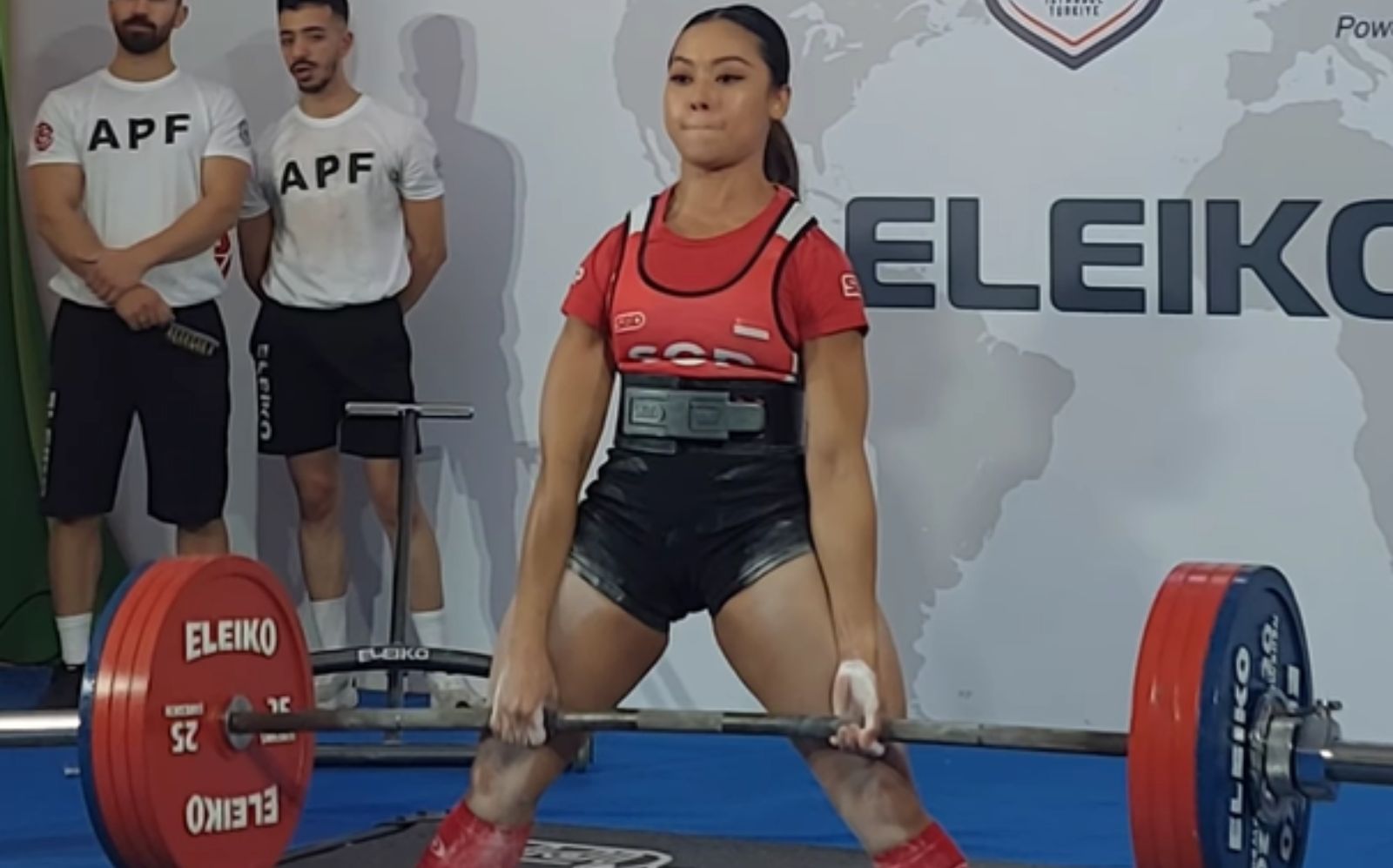As a veteran personal trainer and former powerlifter, I have a lot of love for the barbell deadlift. Despite quitting powerlifting several years ago, the deadlift is still one of my training staples, and I include it in many of my client’s workouts.
That’s because, in my opinion, the deadlift is one of the most productive exercises on the planet.
Few other exercises work as many muscles, teach you how to lift heavy weights safely, or provide as much workout satisfaction. After all, it’s hard to beat the feeling of “gripping and ripping” a heavy barbell off the floor.
But, I also understand that the deadlift is not for everyone. Some people find this exercise tricky or intimidating or are unable to do it because of previous injury or lack of equipment.
The good news is that, while the deadlift is a great exercise, it’s not compulsory, and there are other ways to develop your back, glutes, and hamstrings – even without weights.
In this article, I discuss the bodyweight back extension, which is an effective and popular alternative to barbell deadlifts.
Level Up Your Fitness: Join our 💪 strong community in Fitness Volt Newsletter. Get daily inspiration, expert-backed workouts, nutrition tips, the latest in strength sports, and the support you need to reach your goals. Subscribe for free!
Back Extensions vs. Deadlifts: How Do They Compare?
I’ll be the first person to admit that back extensions (also known as hyperextensions) and deadlifts look very different. But if you examine these exercises, you’ll soon see that there are several important similarities. It’s these similarities that mean you can replace deadlifts with back extensions.
Joint Movement
Many people think that deadlifts are best done like a squat but with the weight in their hands. This is not true. In reality, the squat is a knee-dominant exercise while deadlifts are hip-dominant.
Deadlifts are best classified as a hip hinge exercise, meaning that most of the movement comes from the flexion and extension of the hip joint. While your knees do move, their range of motion is small compared to the hip.
Back extensions are also a hip-dominant movement and they involve a pronounced hip hinge. Sure, the position of your body is different for back extensions and deadlifts, but if you pay attention to your hips, you’ll soon see that the movements are closely related.
Muscle Engagement
Because the movements are similar, both deadlifts and back extensions work many of the same muscles, particularly those around the lower back and hips, which are collectively called the posterior chain.
The muscles that are trained by both exercises are:
- Gluteus maximus (rear of hip)
- Hamstrings (rear of thigh)
- Erector spinae (lower back)
- Core (midsection)
That said, the deadlift involves several additional muscles in the upper and lower body. However, if you want to develop a stronger posterior chain, back extensions can be just as effective as deadlifts.
Ease of Learning
During my 30+ years of working in the fitness industry, I’ve taught hundreds of people how to deadlift. I view it as a skill that every exerciser needs as, after all, it’s the safest way to lift a heavy object off the floor.
That said, some people take to deadlifting quicker than others, and a few never look or feel comfortable when performing this movement. In contrast, most of my trainees get to grips with back extensions almost right away; it’s very much an instant gratification exercise.
So, if you are looking for a straightforward way to train your posterior chain that won’t over-tax your brain, the bodyweight back extension is a great choice.
Related: Deadlift Form 101: How to Lift More Weight Safely
Risk of Injury
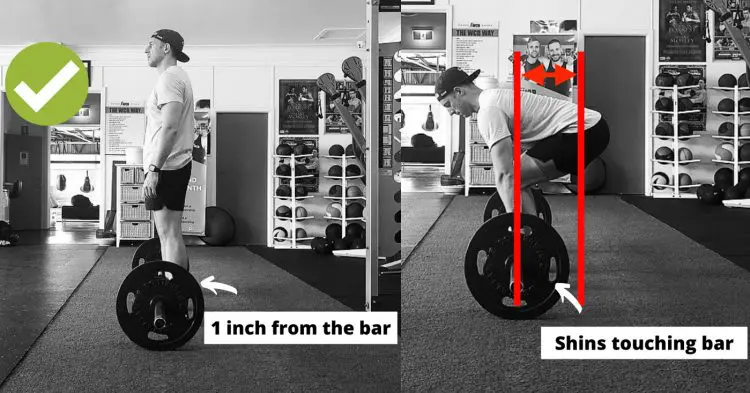
Performed correctly, the deadlift is a relatively safe exercise. If you are unable to complete a rep, you can just release the bar and drop the weight to the floor. However, that weight tends to pull you forward, putting a lot of stress on your lower back. Consequently, back injuries during deadlifts are not uncommon.
In contrast, bodyweight back extensions involve much lower weights and a less technical movement. As a result, they’re arguably safer than deadlifts. That said, a poorly performed back extension can still cause injury, so you must do this exercise correctly.
Read also: 3 Reasons Your Back Hurts After Performing Deadlifts
Accessibility
While you don’t need a lot of equipment to do deadlifts, you will need access to a barbell, weight plates, and collars. You may also need something to protect your floor. Depending on where you train, these items may or may not be available.
In contrast, all you need for back extensions is a suitable incline bench. There are also floor and stability ball variations which make this exercise even more accessible. Back extensions are an excellent home workout alternative to deadlifts.
In summary, while back extensions don’t work your upper body like deadlifts, they are still an effective, safe, and accessible exercise for building a stronger posterior chain. As such, they’re ideal for beginners, home exercisers, and anyone who cannot do deadlifts safely.
Back Extensions: Correct Form
Back extensions are generally easier to learn and safer than deadlifts. However, that doesn’t mean that you can forget all about good form when you do them. Poorly performed back extensions still have the potential to cause injuries.
Follow these step-by-step instructions to make bodyweight back extensions as safe and effective as possible.
Level Up Your Fitness: Join our 💪 strong community in Fitness Volt Newsletter. Get daily inspiration, expert-backed workouts, nutrition tips, the latest in strength sports, and the support you need to reach your goals. Subscribe for free!
- Position your feet so they’re flat on the footplate.
- Using your arms for support, place your hips against the hip pad. The top of the pad should be roughly level with the top of your pelvis.
- Bend your knees slightly and keep them bent for the duration of your set. Brace your core.
- Position your body so your knees, hips, and shoulders form a straight line
- Cross your arms over your chest, with your hands resting on your opposite shoulders.
- Hinging from your hips, lean forward and lower your upper body toward the floor. Lean as far as you can without significantly rounding your lower back.
- Drive your hips forward into the pad and raise your upper body back up.
- Continue for the prescribed number of reps and sets.
Pro-Trainer Tips
Get more from bodyweight back extensions with these tried-and-tested pro-trainer tips!
Use A Slow, Controlled Tempo
A lot of folks do back extensions too quickly; they drop toward the floor and then bounce back up. This is neither safe nor effective. You’ll get more from this exercise if you descend slowly and come up the same way. Take 2-3 seconds to lower your body and another 2-3 seconds to return to the starting position to eliminate momentum and prevent injuries.
Take Each Set to Within a Couple of Reps of Failure
I’m often asked by clients, “How many reps should I do?” To this, my usual reply is, “How many reps CAN you do?” I’m not trying to be awkward, it’s just that with bodyweight exercises it’s hard to prescribe a precise rep range when some people are heavier, lighter, weaker, or stronger than others.
For example, ten reps may be too easy for some people, but much too challenging for others.
You can get around this issue by doing as many back extensions as it takes to fatigue your glutes, hamstrings, and lower back. Stop your set when you feel that you only have 2-4 reps left in the tank. Research tells us that this is hard enough to trigger gains in muscle strength and size (1).
Pause at The Top of Each Rep
Back extensions are arguably hardest when you use your muscles to hold your body straight. This is called the point of peak contraction, and one of the most important parts of any exercise.
Make back extensions even more effective by pausing for 1-2 seconds at the top of each rep – really squeeze your glutes and hamstrings in this position. However, take care not to lean back too far and hyperextend your spine. Like rounding your lower back, an excessive back arch can cause injuries.
Related: 15 Ways to Avoid Back Pain in The Gym
Move Your Arms to Vary the Difficulty
While you can’t easily change your body weight, you can lengthen or shorten your levers to vary the difficulty of this exercise. Put your hands behind your lower back for an easier workout, place them behind your head to make things harder, or extend your arms above your head to maximize the challenge. This gives you four levels of difficulty by simply moving your arms up or down.
To recap:
- Hands behind back – easiest
- Hands on opposite shoulders – moderate
- Hands behind head – harder
- Hands above head – hardest
Avoid Rounding Your Lower Back Excessively
As I often write in my articles and tell my personal training client, a rounded lower back is a weak lower back. Rounding your lower back puts a lot of stress on the ligaments and disks, which are structures that are easy to injure and slow to heal. In contrast, maintaining a neutral (naturally curved) lower back puts that stress where you want it – on your muscles.
So, don’t lean any further forward than your hip flexibility allows. Doing so not only adds nothing to your workout but could cause serious pain and injury. If your hamstrings feel tight during this exercise, it’s probably time to start stretching them more.
Related: The 7 Best Hamstring Stretches for a Healthier Lower Back and Knees
Back Extension Variations and Alternatives
Conventional back extensions are an awesome exercise, and I have no hesitation recommending them to you. However, I also understand that there may be times when this exercise is not your best option.
With that in mind, here are some of my favorite back extension variations and alternatives.
Prone Back Extensions
No back extensions bench? No problem! You can score a reasonable workout by doing back extensions on the floor. The shorter range of motion means your glutes and hamstrings won’t get such an effective workout, but you’ll definitely feel your lower back working during this exercise.
Stability Ball Back Extensions
Stability ball back extensions are very comfortable and a great alternative to doing this exercise on the floor. As well as cushioning your hips, the ball allows you to hinge through a wider range of motion, making the exercise a little more challenging. Place your feet against a wall if you have a heavy upper body and tend to roll forward off the ball.
Weighted Back Extensions
While bodyweight exercises are convenient, they mean that you always work with the same level of resistance. This means that to make an exercise harder, you usually have to do more reps. That said, you can easily add weight to back extensions simply by holding a dumbbell or similar close to your chest.
Prisoner Good Mornings
You don’t need a bench or to lie on the floor to strengthen your posterior chain – just do prisoner good mornings instead. This is a bodyweight version of barbell good mornings, and the name comes from the position of your arms. Like back extensions, this exercise involves a pronounced hip hinge to work your glutes, hamstrings, and lower back.
Closing Thoughts
If I had to choose just one exercise to do for the rest of my life, I’d probably pick deadlifts. It’s not only one of the most productive barbell exercises around, but it’s also one that I really enjoy.
But, that doesn’t mean that deadlifts are right for everyone, or that you need to do them all the time.
Bodyweight back extensions don’t look much like deadlifts, and yet they work many of the same muscles. In addition, for some people, back extensions are safer and more convenient than deadlifts.
So, if you love deadlifts, there is no reason to stop doing them. But, if you are looking for a viable alternative, bodyweight back extensions are an excellent choice.
Related: 7 Deadlift Alternatives – When Deadlifts Aren’t an Option
References:
- Grgic J, Schoenfeld BJ, Orazem J, Sabol F. Effects of resistance training performed to repetition failure or non-failure on muscular strength and hypertrophy: A systematic review and meta-analysis. J Sport Health Sci. 2022 Mar;11(2):202-211. doi: 10.1016/j.jshs.2021.01.007. Epub 2021 Jan 23. PMID: 33497853; PMCID: PMC9068575.

